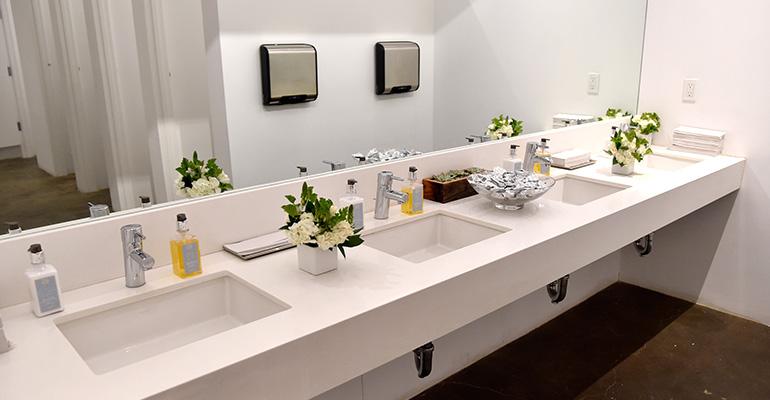You’ve heard it before, but a new survey once again confirms that a dirty restroom sends up a red flag for many of your patrons.
The 2016 Healthy Hand Washing Survey by the restroom fixture manufacturer Bradley Corp. revealed some not-so-secret behaviors found in public bathrooms. The results also point to ways restaurants can meet guests’ expectations about restroom facilities.
A key takeaway from the survey is that patrons think poorly of businesses with dirty restrooms. Most Americans say that a messy restroom signifies poor management and shows the business doesn’t care about its appearance or its customers.
They find certain restroom problems more aggravating than others.
Biggest pet peeve? Like Seinfeld’s Elaine, they dread facing an empty or jammed toilet paper dispenser.
Next most bothersome situations are stall doors that don’t latch, an overall dirty or unkempt appearance and empty or jammed towel or soap dispensers.
Restroom users in the survey think the situation is worsening, too. Almost 70 percent report having had an unpleasant experience due to the conditions in a public restroom—up from 51 percent in 2012.
Consumers have suggestions for ways to improve the situation. Key enhancements they would like to see in public restrooms include more frequent cleaning, access to all touchless fixtures, regular stocking of materials and lots of paper towels—even if dryers are available.
For a variety of reasons, consumers say they are reluctant to touch certain restroom surfaces. Restroom door handles, stall doors and faucets top the list of surfaces consumers dislike touching the most, followed by countertops, sinks and soap and towel dispensers. People go to great lengths to dodge germs in public restrooms. They flush the toilet using their foot, use a paper towel when touching the restroom door and faucet handles and open and close doors with their hip.
And even if they intend to wash their hands, many don’t, often because of a lack of resources in the wash area—specifically, soap or paper towels—and sinks that either aren’t working or seem unsanitary.
Among other survey results, these two give us pause:
• Many restroom users, especially men, skip the suds. Almost 80 percent or respondents said they frequently or occasionally see others leave a public restroom without washing their hands, especially in the men’s room. Men also are less likely to wash up than women; 20 percent disclosed they skip washing because they “didn’t feel the need.”
• A small but not insignificant percentage of Americans use their “me time” to take cell phone breaks in the stalls. Texting, checking/sending email, checking/posting on social media and surfing the web are the most common activities. Six percent of all survey respondents admit they’ve taken a photo in the stall (what, we wonder, could be so terribly interesting?), while eight percent of men say they’ve checked their fantasy sports league.
For restaurant operators, then, two questions remain: How many of those hand-washing scofflaws and stall phone users are your employees? A recent study from the U.K. found that 92 percent of mobile phones had bacterial contamination, while one in six contained fecal matter.
These results not only point up the importance of clean, functional bathrooms, they also underscore the need for ongoing and thorough procedures for employees using those bathrooms.
The survey asked 1,062 American adults online Dec. 10-13, 2015 about their hand-washing habits in public restrooms and concerns about germs, colds and the flu. Participants were from around the country, were 18 years and older and were roughly divided between men and women (47 and 53 percent).





